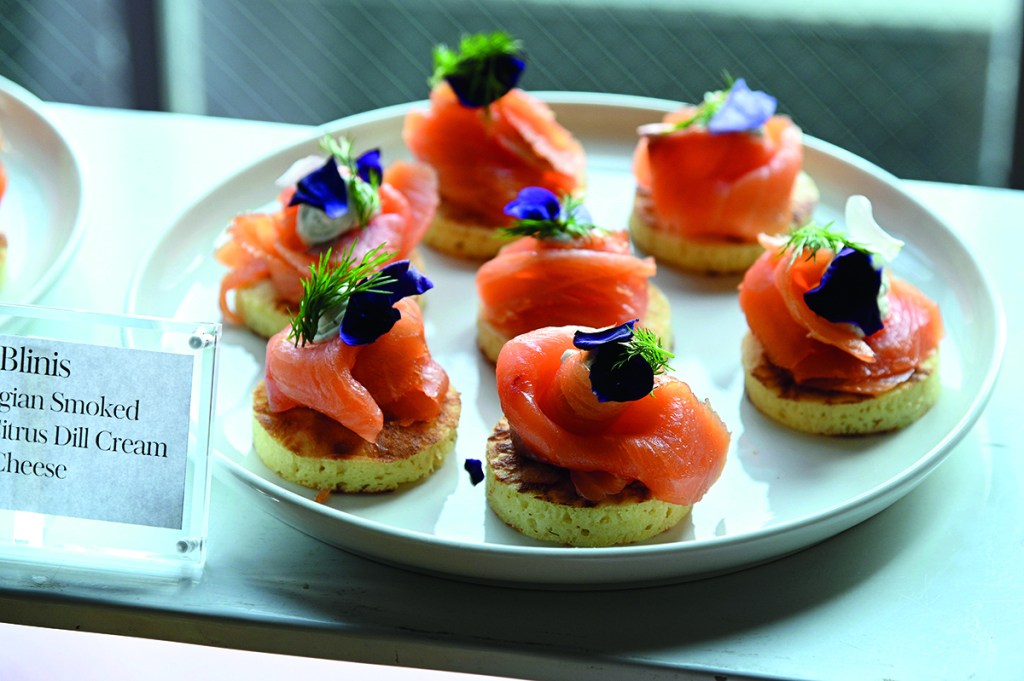It’s hard to keep up with the French. First they invent a perfectly good culinary term, hors d’oeuvre, which as everyone knows refers to the bite-sized appetizers served at cocktail hour. We Anglos, in keeping with our ancestral custom, duly pirate the word and put it to work in kitchens on three continents. But barely have we wrestled the silent h into submission and gotten the vowels in oeuvre sorted out (is that ue or eu?), when the French — who had permitted their attention to wander for a brief space — deign to take note of our efforts, lifting a single languid eyebrow: ‘What? Hors d’oeuvres? Oh, you mean amuse-bouches?’
Stop the presses, everyone; cancel the cookbooks; send the menus back to the printshop. It’s an amuse bouche now…but will the term ever make it into common usage on this side of the pond, outside of a few chic restaurants and culinary in groups? I doubt it, for American heads are still throbbing with the cultural hangover from Puritanism, as excoriated by H.L. Mencken. The ghosts of John Calvin and the Pilgrim Fathers recoil with horror at the very idea of an amuse-bouche, leaning out from beyond the grave to condemn the frivolity of referring to food as a mere amusement for the mouth. Food is serious business, y’all.
Playing around with food remains a social solecism in more than one neck of the woods. Yet the hors d’oeuvre at its finest is undistilled playfulness: whimsical bitesized compositions of flavors, textures, colors and shapes, designed to please the eye, tickle the palate and impart to the higher faculties an invigorating rush of the mingled delight and satisfaction known to the cognoscenti as appreciation. Consider the light-hearted exquisiteness of a single mouthful of cold avocado Champagne soup served in a gold-rimmed crystal shot glass, topped with a flourish of whipped cream and a mint leaf. What a thing is man, that he can derive one part amusement and two parts delight from perching an antler-like arabesque of shiitake mushroom shavings on top of Roquefort and a roasted pear chip, drizzling the entire thing with thyme-infused honey, and serving it to his friends! How pleasing it is to make short work of a cracker laden with wagyu carpaccio, slivered asiago, sorrel micro-greens and fermented wild grape gelée, washed down with Sauternes. And for the culinary equivalent of a pun, try serving a round scoop of Greek yogurt blended with chopped cucumber, mint, dill and lemon in a mini-cone, like a tiny helping of pistachio ice cream, topped with caviar masquerading as fruit.
Properly done, the amuse-bouche is a form of sprezzatura, the nonchalant accomplishment of a difficult and dazzling feat. For however complex an amuse-bouche may be, it must not take itself seriously; its moment in the limelight is brief and, in the best circles, quickly forgotten. ‘Unlike the opera overture,’ the authors of the classic Joy of Cooking advise, ‘the hors d’oeuvres course should not forecast any of the joys that are to follow.’ If feta cheese puts in an appearance, scratch Greek salad from the menu. If spears of asparagus wrapped in prosciutto were passed around, asparagus is persona non grata at dinner.
The estimable authors of Joy would doubtless appreciate vocal ensemble I Fagiolini’s musical spin on pre-prandial nibbles: their 2016 album Amuse-Bouche draws a clever aural parallel between early 20th century French music and the elegant, ephemeral hors d’oeuvre, notably in a 12-voice musical spoof on gastronomy by Jean Françaix. Where the album misses the mark, in my view, is that while claiming to send up hedonism, it bills itself as unashamedly hedonistic. That seems terribly unfair to the sparkling potential of the amuse-bouche. A thing of beauty is a joy forever, said Keats, so why must appreciation of these lovely soap bubbles be reduced to hedonism?
Gluttony is of course real. But it extinguishes part of the happiness to be had in appreciating and sharing fine food. I’ve never had patience for food writing that natters on about saliva and gullets and gushing juices and crunching mandibles (looking at you, Anthony Bourdain). Surely inflicting one’s slurpings and champings on others is poor manners, whether or not one is being paid 50 cents a word to do so. Just as bad are the grimly austere who view food solely in terms of fuel: meal-replacement powders, anyone? Hedonism and puritanism are two sides of the same coin, both contemptuously denying the body any participation in the higher delights of the spirit.
A study conducted a few years ago by a team of North American and French scholars found that we in North America tend to value food especially as it relates to comfort, health and convenience — a lonely approach, it seems to me. In contrast, our Gallic counterparts turn to it for joy, seeing in cuisine an opportunity to create and appreciate the unique things that make life interesting. Elements of this divided perspective can be traced back to the Protestant Reformation, when Calvinists and Puritans worked to change the way people related to food.
Late-medieval Europeans followed a deeply ingrained annual cycle of fasting and feasting, inculcated by centuries of Catholicism. The year was dotted with celebrations of Our Lady, such as Lady Day and Candlemas, and feasts of local patron saints. The things people ate or didn’t eat were expressive of the emotions appropriate to the occasion: happiness at Christmas, sorrow on Good Friday. To the Catholic medieval psyche, all food possessed a faintly sacramental character, since Christ had chosen ordinary bread and wine to be transformed into his body and blood. Even common food became by analogy a sort of currency of love.
The reformers knew that if they wanted to wean ordinary people off veneration of Our Lady and the saints, it would take more than theory from the pulpit: customs and mentalities would have to change. Otherwise people would relapse into their familiar and beloved habits as soon as the divines looked the other way. The reformers were also anxious to combat belief in transubstantiation, the doctrine at the heart of the Catholic sacrament of the Holy Eucharist. Recent scholarship has cast a light upon the methods used by reformers under the influence of Calvin to divest food of its sacramental connotations and to downplay its celebratory aspect, emphasizing instead its dutiful consumption for the sake of health.
Shakespeare’s puritanical Malvolio takes a beating on that score: ‘Dost thou think, because thou art virtuous, there shall be no more cakes and ale?’ Turns out Calvin and his pals did think that because they were virtuous, there should be no more cakes and ale. No oysters on the half-shell with Parmesan and garlic butter. No baked mini-endive compotes with foie gras and pistachio crumble topping. No little woven cracker baskets filled with trout mousse, poached quail’s egg and caviar.
No joie de vivre, in short. When the goodness of food becomes sinful, virtue is redefined to mean calorie counting, meal-replacement powders and protein shakes. This is the way the world ends: not with a feast, but a Fitbit.
This article was originally published in The Spectator’s January 2021 US edition.

























